|
Raw lacquer is the sap of the lacquer tree, which hardens in contact with air. A tree becomes productive 3-5 years after planting. Lacquer trees secrete the latex in June and July each year and they must be tapped it in the predawn hours before the sunrise because the sun would reduce the moisture in the air, stopping the flow of the latex.
A wood-based red lacquer bowl made 6,000 - 7,000 years ago unveiled the history of lacquer techniques. Early pieces were in simple red and black. During the Warring States Period (476 BC - 221 BC) and the Han Dynasty (206 BC – 220AD), lacquer ware demonstrated exquisite techniques and vivid patterns such as animals and clouds. Lacquer wares excavated in the Mawangdui Han Tomb which have a history of over 2,000 years, amaze visitors with their pearl-like sheen. The Yuan, Ming and Qing dynasties were also prosperous periods during which time more than 400 varieties of lacquer ware were used as common implements and as ornaments.
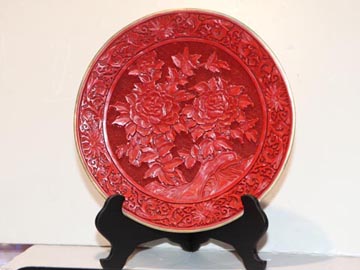 |
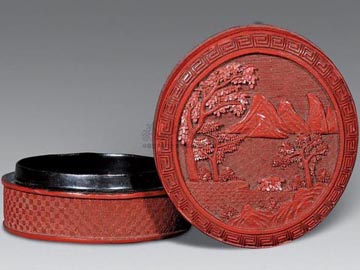 |
Lacquer
Ware Plate |
Lacquer
Ware Box |
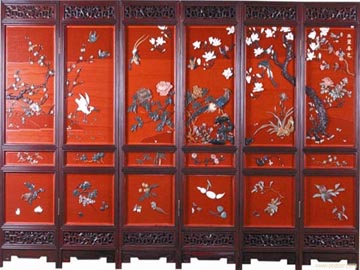 |
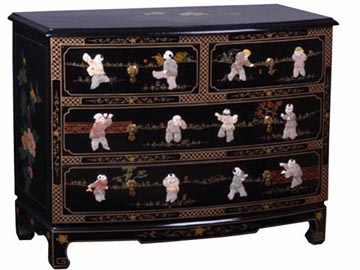 |
Lacquer
Ware Screen |
Lacquer
Ware Furniture |
Before the invention of the Chinese ink, lacquer had been used for writing. Twenty-eight bamboo clips found in a Warring States (475-221 B. C.) tomb at Changtaiguan, Xinyang, Henan Province, bear a list of the burial objects with the characters written in lacquer.
Lacquer ware is moisture-proof, resistant to heat, acid and alkali, and its color and luster are highly durable, adding beauty to its practical use. Beijing, Fuzhou and Yangzhou are the cities leading in the production of Chinese lacquer ware.
The making of Beijing lacquer ware starts with a brass or wooden body. After preparation and polishing, it is coated with several dozen up to hundreds of layers of lacquer, reaching a total thickness of 5 to 18 millimeters. Then, gravers will cut into the hardened lacquer, creating "carved paintings" of landscapes, human figures, flowers and birds. It is then finished by drying and polishing. Traditional Beijing lacquer objects are in the forms of chairs, screens, tea tables, vases, etc. Emperor Qianlong of the Qing Dynasty, an enthusiast for lacquer ware, had his coffin decorated with carved lacquer.
Yangzhou lacquer articles are distinguished not only by carvings in relief but by exquisite patterns inlaid with gems, gold, ivory and mother of pearl. The products are normally screens, cabinets, tables, chairs, vases, trays, cups, boxes and ashtrays.
Fuzhou is well-known for the "bodiless lacquer ware", one of the "Three Treasures" of Chinese arts and crafts (the other two being Beijing cloisonné and Jingdezhen porcelain).
The bodiless lacquer ware starts with a body of clay, plaster or wood. Grass linen or silk is pasted onto it, layer after layer, with lacquer as the binder. The original body is removed after the outer cloth shell has dried in the shade. This is then smoothed with putty, polished, and coated with layers of lacquer. After being carved with colorful patterns, it becomes the bodiless lacquer ware of extremely light weight and exquisite finish.
Pingyao, an ancient town in Shanxi Province, also produces lacquer ware which features the brilliant luster polished by craftsmen's palms. This simple but radiant artwork is very refined. Here are some lacquer ware on sale. If you have interest please contact me.
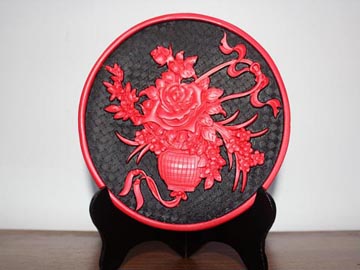 |
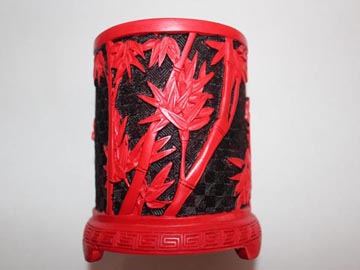 |
Lacquer
Plate |
Lacquer
Pen Container |
Mobile:(+86-13501103837)
Wechat:(13501103837)
E-mail: chinasilkrug@msn.com